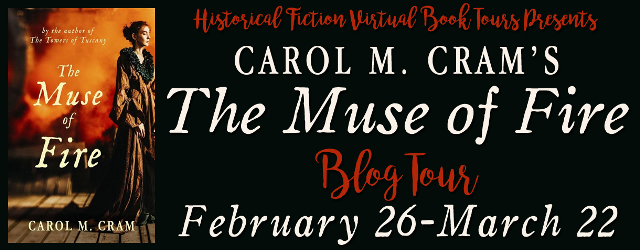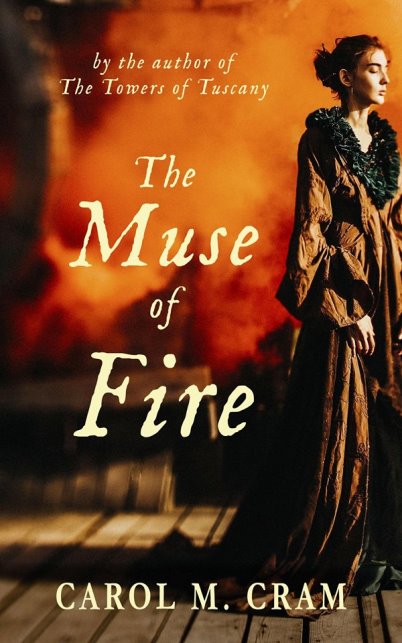Behind the Scenes of The Muse of Fire by Carol M. Cram
The Muse of Fire tells the story of a young woman stepping into a career on the stage in early 19th century London. The respectability of the theater as a profession for a woman was improving during this period. Some women—most notably tragic actress Sarah Siddons and comic actress Dora Jordan—were hugely famous for their work on the stage. Opportunities for women were slowly opening up at the same time as social upheaval made the early 19th century a particularly fraught era for the theater.Following is an overview of the historical context for The Muse of Fire.
The novel takes place between 1808 and 1809, a time of great social and political upheaval in Britain. The red circle on the current map of London shows the extent of the city during the novel.
 |
| Source: The London Evolution Animator |
 |
| Source: Picture Alliance |
During the time of the novel, the Napoleonic Wars were raging and the practice of press-ganging men into the Navy was rampant. A press gangs was essentially a group of state-sanctioned bullies who scoured the taverns in port cities such as London, Bristol, and Liverpool, got unsuspecting young men drunk, and then knocked them out and dragged them to ships waiting at anchor in the harbor. By the time the poor men woke up, there were out at sea and serving—whether they wanted to or not—in the King’s Navy. In The Muse of Fire, press-ganging plays an important role in the fate of one of the main characters. Here’s a caricature of the press gang in 1780.
 |
| Source: Press-Ganging |
On the up side, this was also the period of graceful architecture. Here’s the beautifully-proportioned colonnade built along one side of the Piazza at Covent Garden where the novel takes place.
 |
| Source: Covent Garden Colonnade |
The Muse of Fire completes my themed trilogy about women in the arts – painting in The Towers of Tuscany, music in A Woman of Note and the theater in The Muse of Fire. I was intrigued that one of the only ways in which a woman could become rich and famous during the early 19th century was to go on stage as an actress or a performer.
At my presentations of The Muse of Fire, I ask audiences to call out the names of famous and influential woman of today. Always, without exception, I hear the names of women who are famous because of their work in show business or the arts – Oprah, J.K. Rowling, Madonna . . . I’ve yet to hear anyone say the name of a female politician or a woman known in a realm outside of entertainment. While the status of women has certainly improved since 1809, we still have a fair way to go in terms of influence!
The Muse of Fire takes place at the Theatre Royal, Covent Garden, the largest theater in London and one of only two theaters licensed to produce Shakespeare plays and other serious drama. A recurring concern in the novel is how the growth of the physical theater during this period led to the production of bigger and more elaborate spectacles and melodramas. People were always lamenting the demise of “real drama.”
Here is a painting of the interior of the Theater Royal at Covent Garden.
 |
| Source: Covent Garden Theater: 1809 |
People seated in the pigeon holes could only see the legs of the actors.
The design of the theater—and people’s objections to it—plays an important role in The Muse of Fire.
Some of the most famous actors and actresses took to the stage during the period of the novel—and several of them make cameo appearances. One of the most famous actresses is Sarah Siddons. Known as The Tragic Muse, Mrs. Siddons was a tall, striking figure who dominated the stage with her powerful and emotional acting. She was particularly known for her performances as Lady Macbeth. In her lifetime, Sarah was incredibly famous – the rock star of her day. She did well financially, but unfortunately her husband was in charge of her money and was constantly losing it so she was often strapped for cash and obliged to perform benefits to raise money.
Another very famous actress was Dora Jordan who was considered the greatest comic actress of her time. She was particularly known for her performances in breeches parts such as Rosalind in As You Like It. Dora Jordan was also the mistress of the Duke of Clarence with whom she had 10 children. Her fame and her relationship didn’t help her in the end. The Duke of Clarence – who was the brother of the Prince Regent and went on to become William the IV, Queen Victoria’s uncle—was not permitted to marry Mrs. Jordan. He took custody of the children and Mrs. Jordan died in poverty in 1816.
The most famous male actor of the period was John Philip Kemble, the brother of Mrs. Siddons. Mr. Kemble plays a major role in The Muse of Fire, which weaves the stories of fictional characters into real life events. Mr. Kemble was also the manager of Covent Garden theater and was known for being very stern and unbending.
A key event in The Muse of Fire is the burning down of Covent Garden theater on September 20, 1808. The theater was flattened and 22 people killed. Fast forward a year. Many things happened to the characters in The Muse of Fire during that time culminating in the opening of the new theater on September 18, 1809 with a production of Macbeth. Here’s the playbill for the performance starring Mr. Kemble as Macbeth, his brother Charles Kemble as Macduff and his sister Sarah Siddons as Lady Macbeth.
Prior to opening night, the ticket prices for the New Theatre, Covent Garden, were increased, leading to one of the most explosive opening nights in British theatrical history.
For the full story, check out The Muse of Fire.
The Muse of Fire by Carol M. Cram
Publication Date: December 26, 2017
eBook; Kindle Press
Paperback; New Arcadia Publishing
Genre: Historical Fiction
Abandoned at birth, the grandly christened Edward Plantagenet rises from London’s Foundling Hospital to take charge back stage at the Theatre Royal, Covent Garden, only to be blind-sided when he rescues Grace—a young woman escaping an abusive father.
Grace finds an outlet for her passions as a Shakespearean actress, becoming ensnared by intrigues and setbacks that mar the pathway to stardom she craves.
Set against the tumultuous backdrop of the Old Price Riots of 1809, Grace and Ned find common purpose in a quest that threatens to tear both their worlds apart.
"Meticulously researched and with an atmosphere so rich that one can almost smell the face powder, The Muse of Fire is another triumph for Carol M. Cram. The irresistible story at its heart is impeccably woven into the tapestry of British theatrical history with such precision that Grace and Ned might have stepped from the pages of the Georgian gossip sheets and straight into fiction. The Muse of Fire will linger long after reading. It’s not to be missed!" – Catherine Curzon, author of Queens of Georgian Britain, Life in the Georgian Court, and Kings of Georgian Britain
Amazon | Barnes and Noble | IndieBound
About the Author
 Carol M. Cram is the author of A Woman of Note (Lake Union Publishing, 2015) and The Towers of Tuscany (Lake Union Publishing 2014). In addition to writing fiction, Carol has enjoyed a great career as an educator, teaching at Capilano University in North Vancouver for over twenty years and authoring forty-plus bestselling textbooks on business communications and software applications for Cengage Learning. She holds an MA in Drama from the University of Toronto and an MBA from Heriot-Watt University in Edinburgh, Scotland. Carol is currently focusing as much of her attention as she can spare between walks in the woods on writing historical novels with an arts twist and sharing her Nia practice as a Nia teacher. She and her husband, painter Gregg Simpson, share a life on beautiful Bowen Island near Vancouver, Canada.
Carol M. Cram is the author of A Woman of Note (Lake Union Publishing, 2015) and The Towers of Tuscany (Lake Union Publishing 2014). In addition to writing fiction, Carol has enjoyed a great career as an educator, teaching at Capilano University in North Vancouver for over twenty years and authoring forty-plus bestselling textbooks on business communications and software applications for Cengage Learning. She holds an MA in Drama from the University of Toronto and an MBA from Heriot-Watt University in Edinburgh, Scotland. Carol is currently focusing as much of her attention as she can spare between walks in the woods on writing historical novels with an arts twist and sharing her Nia practice as a Nia teacher. She and her husband, painter Gregg Simpson, share a life on beautiful Bowen Island near Vancouver, Canada.For more information, please visit Carol M. Cram's website. You can also find her on Facebook, Twitter, Pinterest, and Goodreads.
Blog Tour Schedule
Monday, February 26Review at Peppermint Ph.D.
Excerpt at What Is That Book About
Tuesday, February 27
Interview at Donna's Book Blog
Feature at View from the Birdhouse
Thursday, March 1
Review at Teaser Addicts Book Blog
Friday, March 2
Review at A Bookaholic Swede
Feature at A Literary Vacation
Excerpt at Locks, Hooks and Books
Monday, March 5
Review at Svetlana's Reads and Views
Thursday, March 8
Interview at Passages to the Past
Friday, March 9
Review at Pursuing Stacie
Wednesday, March 14
Review at History From a Woman's Perspective
Monday, March 19
Review at Books of a Shy Girl
Guest Post at Let Them Read Books
Tuesday, March 20
Review at Clarissa Reads it All
Thursday, March 22
Review at Historical Fiction with Spirit
Giveaway
During the Blog Tour we will be giving away three paperback copies of The Muse of Fire! To enter, please enter via the Gleam form below.Giveaway Rules
– Giveaway ends at 11:59pm EST on March 22nd. You must be 18 or older to enter.
– Giveaway is open to residents in the US and UK.
– Only one entry per household.
– All giveaway entrants agree to be honest and not cheat the systems; any suspect of fraud is decided upon by blog/site owner and the sponsor, and entrants may be disqualified at our discretion.
– Winner has 48 hours to claim prize or new winner is chosen.
The Muse of Fire



















No comments:
Post a Comment